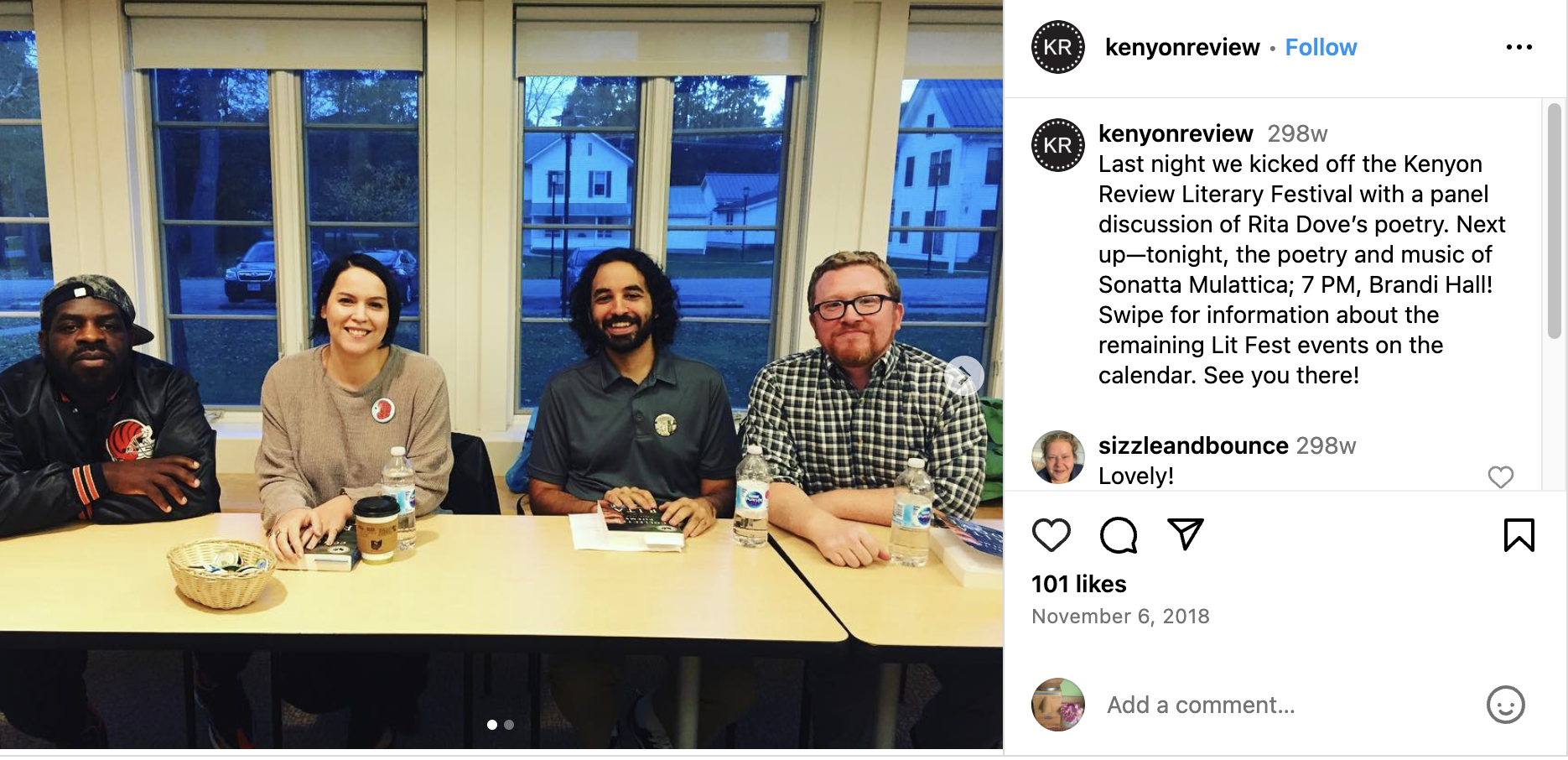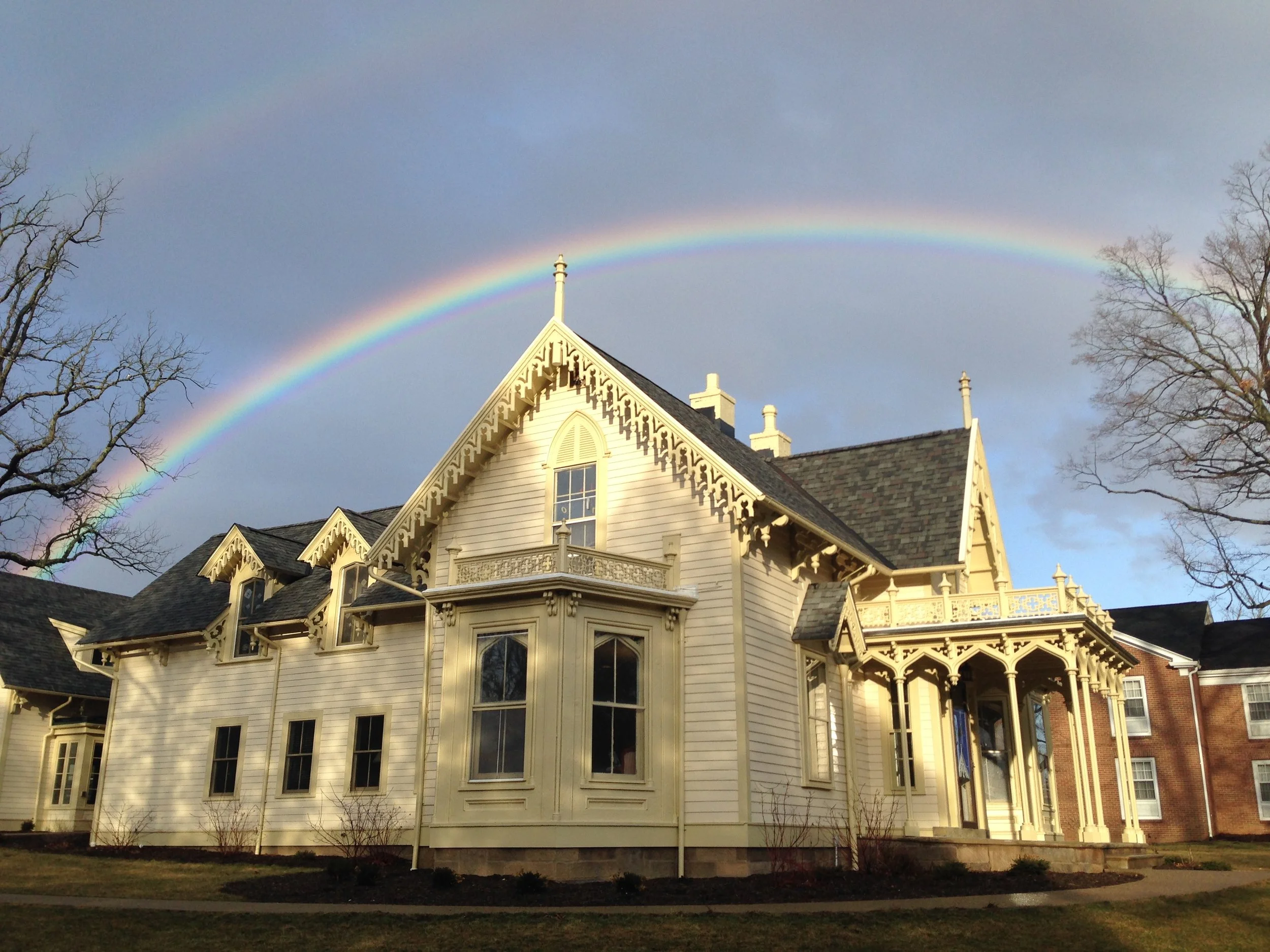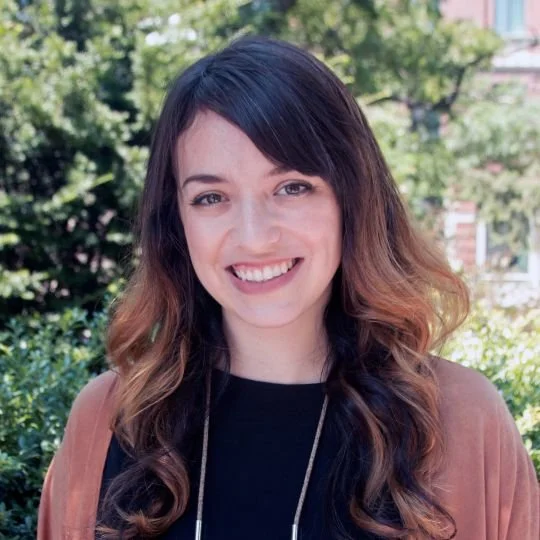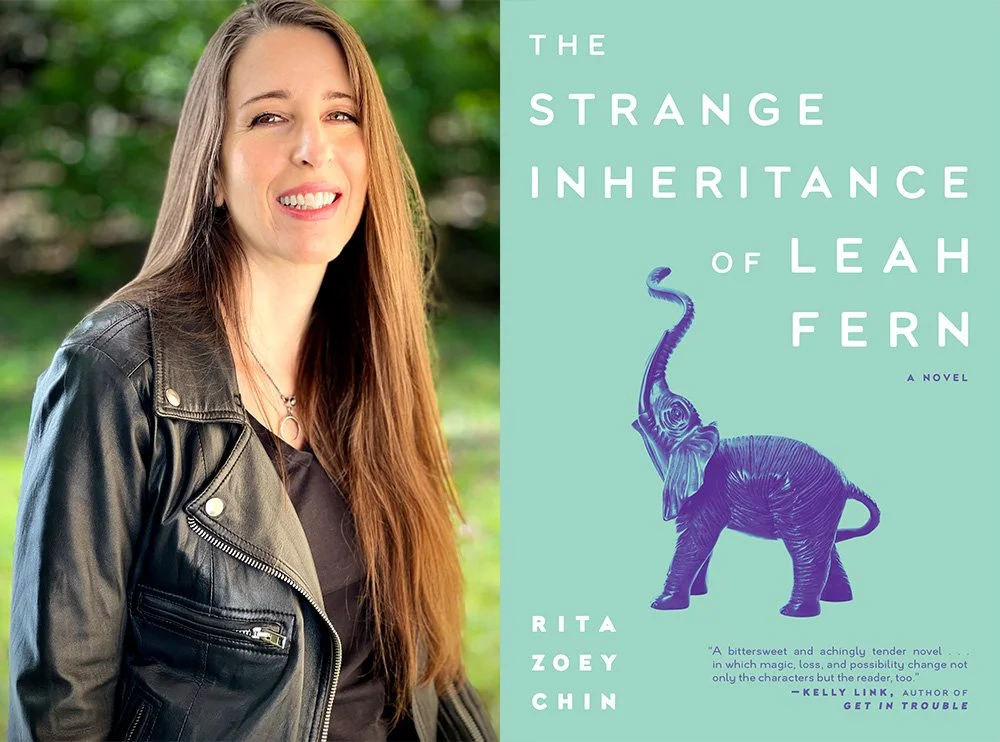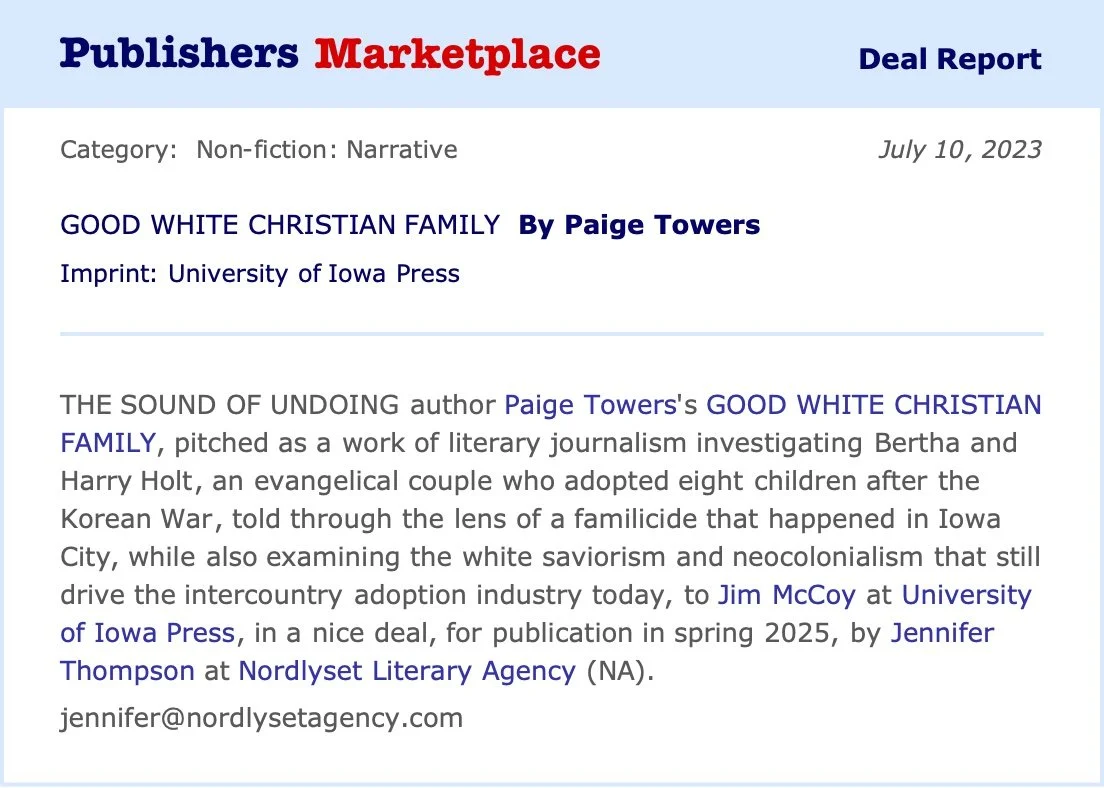I’m Kirsten Reach, an editor. Jonquil Editorial is my editorial consulting firm, and I work with publishers as well as authors like Ruth Awad, Jacqueline Alnes, and Ilya Kaminsky.
Learn more about my current authors, or check out my newsletter.
Dear Mona Simpson, Emily Stokes, and Kelley Deane McKinney,
I first became a subscriber to The Paris Review when Philip Gourevitch was editor; particularly liked Caitlin Roper’s issue; admired the design changes (as well as many pieces published) during Lorin Stein’s years; I traced back to Brigid Hughes’s work for the magazine after I started subscribing to A Public Space. One thing I’ve always admired about your magazine is that the journal takes time to do things well, and each item it publishes so impeccably feels like it might be connected to one years past, or one coming in the next issue.
I’d love to see more conversation about the risks you’re taking with the prose in the journal, and how you’re balancing debut writers with more established voices, and what about that specific balance feels like it’s working or not working. Doing our own rough VIDA count tally for the Kenyon Review at my desk each year, it can be a hard line to walk—even when you have a very strong and thoughtful team of editors, if you’re lucky enough to have many eyes on your publication, there will be some scrutiny that is worth the staff listening to and discussing together.
Like the Kenyon Review, you have settled on a more approachable trim size, something that feels a bit friendlier to pick up. I’m curious how your readers have responded (I’d wager they like it) and how it has changed your process. Did you move to a new printer, or have to adjust the dimensions for your artists?
In a statement after Emily Stokes’s editorship was announced, co-presidents Matt Holt and Akash Shah said that you are reaching the “broadest and largest audience in [the magazine’s] history.” I’m eager to drill down: Where is your readership growing? What pieces bring evergreen traffic to your site? I’m curious if the CIA piece gained significant traction, since social media seems to tumble around with a “new” article about CIA funding that always brought some new readers to the Kenyon Review.
A few significant changes in my time at KR: We started to focus on growing our audience online, especially through social media. We made new attempts to make the reading series more broadly accessible, both in filming and in providing closed captions. We said that the online magazine was as strong as the print magazine, so I wrote a proposal to our board about not just paying writers in both outlets the same amount, but investing in the same editorial process, and we implemented that change. We added new audio content with a program called KR Out Loud. I campaigned for a print publication arm so we could take on some books in addition to our magazine, but we didn’t have the bandwidth to launch that program in my six years at the magazine.
I’ve had time to learn the scrappy way to film, broadcast, and reach our new readers. Now I’m curious how a magazine with a broader reach, and a no less complex publishing history, is growing and changing in 2024.
When I left New York, I had no idea I’d be live-streaming WORD Bookstore events from the back porch, but our world has changed and grown in strange, inspiring ways through the pandemic—suddenly it would be hard to picture a week without a meeting with novelist Nick White in person on Monday, and a virtual conversation with Eugene Lim and Ian Dreiblatt at City Lights on Tuesday; an executive committee meeting with the Editorial Freelancers Association on Wednesday, and so on.
I’m shuffling together a stack of experiences with the magazine below to demonstrate that I’ve already been doing the work you are looking for a Senior Editor to do. I’ve sought out and published exciting new voices, and continued to work with those authors as their careers grow and twist. I’ve managed a team of book review editors, and freelance readers, and trained student interns to read and copyedit. I’ve led the podcast, social media, and written for the blog and newsletter; I can write an introduction for an author or come up with questions for an author in conversation with only an hour’s notice (though a little lead time is ideal); I can build a group of invested alumni of the organization, and keep up with them so that we can continue to pull them back for events or even recruit them for the board when they feel like the right fit; I can engage with a library conversation about a community read, or guide a conversation about a story in the issue in a board room. Right now, though, I’m focused on editing prose, mainly books of fiction and nonfiction, with a little steady work for a food writing blog that has kept me abreast of best practices in SEO and other marketing issues that change so frequently, I find it’s best to keep a toe in the water.
My taste is on the quirkier side of what you publish. I worked with many offbeat writers at Melville House, from Lynne Truss to Phillip Hoare to Jeremy Bushnell and Catie Disabato. I’m including some highlights from this work below. I started my own editorial consulting firm a few years ago and have been working full-time with authors like Ilya Kaminsky, Elena Sheppard, Geeta Kothari, Ellen O’Connell Whittet, Andy Grace, Ruth Awad, Jacqueline Alnes, Rita Zoey Chin, and Meryl Natchez.
Each interview I encounter in your pages leads to a hall of doors. Mary Robison took me back to a Bomb Magazine interview (and reminded me to check whether Mary Swan has ever released another book); it brought me to check on one of her previous interviewers, who recently lost her mother (someone I published at the Kenyon Review, who sent me a stack of books when I had my daughter). Like going to the same place each summer on vacation, there’s a sense that this place has been waiting and we’ve been in conversation already for years. This is part of what makes so many readers and subscribers feel connected and engaged with you.
I’d be delighted to continue this conversation with the extension of a phone or in-person interview. Please feel free to email or call if my experience sounds like a good fit. I know your time is limited. Thank you, sincerely, for your consideration.
With best wishes,
Kirsten Reach
My next goal was to form new connections
Following the initiative of a board member, Marcy Barr-Abbot, I built an alumni network for former associates of the Kenyon Review. We met in New York, L.A., DC, and other cities that aligned with the AWP Conference. I scooped ice cream for our visiting alumni annually, and arranged readings for the same event.
I selected readers, reached out to them, contracted them, worked with the board to arrange the space and time, put together the guest list, designed and disseminated social media posts, and emailed folks directly to ask them to join us. Our reading at Friends & Lovers in Brooklyn, over 100 people were in attendance.
When I worked for the Kenyon Review, we found that print readers were generally male, over 55, Jewish, and living in New York. Our online magazine readers were generally female, between 25 and 40, and living in a completely different part of the US.
I tried to reflect this visual identity in our social media channels. To build on this nostalgic feel, I pulled together items from our office to style our covers for Instagram before each issue’s launch (like this one from Jan/Feb 2017).
As Director of Social Media, I made an effort to highlight our fellows and local writers in conversation, like this Rita Dove panel from 2018. We launched our YouTube channel around this time, and it was a bit of a learning curve — we eventually designed a banner to improve the professional look on video, and found better ways to handle our sound in the small space. We added a leading image with large text to introduce each reader, and to save us from messy still shots.
One of my proudest AWP moments was convincing editors from Tin House and One Story to throw a dance party with the Kenyon Review. We pooled funds for drink tickets and invited some of our favorite writers to come up with the playlists. It was packed! It helped to boost engagement with younger writers, and many of them submitted to us the following year.
If you look closely, you’ll see that the pages in the foreground are from Ann Hamilton’s “human carriage” (installed at the Guggenheim in 2009), which were in a staff member’s office.
“Coffins Patch” by Rachel Heng (Jan/Feb 2021). Rachel studied with former fiction editor Nancy Zafris, who wrote to connect us. I published her story “You Know I Want It Ice Cold” in our online magazine, and we kept in touch. This was a tender story about miscarriage, and I’m grateful we built the kind of editorial relationship where she would send us new work that took these kinds of risks. This was the first story I was able to accept under our new editor, Nicole Terez Dutton.
“Snow Line” by Elizabeth Brinsfield (Mar/Apr 2019). The author and I revised this over the phone for months. The climax is composed of many small gestures in a tight room, and as we tried to order them, I drew a map so we could work out where the table was, where the protagonist’s son was, and where the dangerous neighbor was standing—between the pregnant protagonist and the door.
A small detail I love: the author includes a mention of deer, and the timing of these was significant, since the population died out almost completely and returned by the year in which the story was set.
“Butter” by Eve Gleichman, winner of the Short Fiction Prize (Jan/Feb 2017). I managed submissions for the prizes, hired the guest judges, and worked with student interns to narrow the pool down to about ten submissions. My intern and I were thrilled with this piece when we met in my office to discuss it, and I called her as soon as we got the final word from Jaimy Gordon that it had won. Later I invited Eve to read in Brooklyn as part of an alumni event at Friends & Lovers, and years later they sent us “The Quiet Current,” which I published in July/August 2020. Eve co-authored a novel, The Very Nice Box, with with Laura Blackett. It was a New York Times Editors' Choice and an Apple Book of the Month.
“On Poverty” by Alison Stine (February 2016), a response to Claire Vaye Watkins’s “On Pandering,” took us months of work. We had published Alison’s poems many years ago, and she approached us by email with an idea for a post. As the months and drafts went on, I encouraged her to make this less a criticism of Watkins’s dismissal of rural Pennsylvania and to make the argument independent of this piece.
Her blog post became our most-trafficked piece on the Kenyon Review site, and it was the first blog post at KR ever nominated for a Pushcart. Since this hit piece, she has continued to pursue writing about being a writer and single parent living below the poverty line in rural Appalachia.
Mia Alvar was gracious enough to serve as judge for the 2019 Short Fiction Prize. Winner Daphne Palsai Andreades read her story outside of the office on the last day of our summer workshop. “Brown Girls”—first published in our contest the Kenyon Review—was selected by Chimamanda Ngozi Adichie for an O. Henry Prize, and was sold as an expanded project to Random House (US), 4th Estate (UK), Luchterhand (Germany) and Les Escales (France).
Selections from the work I solicited and/or edited for the Kenyon Review
I wanted to make our literary arts organization more visible to readers all over the world
My first email as Kenyon Review editor was to Hilary Mantel, whom I’d worked with at Henry Holt on her two Man Booker Prize winning titles. I invited her to receive our Award for Literary Achievement, and she and her husband Gerald flew in to Gambier and New York to accept.
One of our biggest, and most successful online events was "A Winter Evening of Poetry and Song" with Shira Erlichman, Ross Gay, and Saeed Jones. This was one of our first live events with closed captioning. This was an event where we followed the lead of our speakers, and it felt like their creative energy fused, even from a distance, in the early stages of the pandemic.
The night Rita Dove accepted the Award for Literary Achievement in New York, our student associates gave readings from the book accompanied by a performance of Beethoven’s "Violin Sonata No. 9" by Alayne Wegner. For context, Rita Dove’s Sonata Mulattica focuses on the relationship between Ludwig van Beethoven and biracial violinist George Bridgetower. Our social media team had to be on the ground in both locations.
Colm Tóibín accepts the Kenyon Review Award for Literary Achievement at the Rainbow Room in NYC on November 9, 2017. The highlight is the final moment of his talk when he traces the word "thole," which appeared in an Old English work he was translating, through Scotland to Northern Ireland, to "Here Lies A Lady," a poem by John Crowe Ransom, founder of the Kenyon Review. This may not have as much appeal for our younger readers and followers, but it's another moment we were able to see a strong connection between our publication and the history of a single word.
Overseeing our three book review editors, I helped to launch a new book review section, where we covered 100 books a year (mainly work from small presses or in translation, where review coverage was sorely needed)
Adam Clay, Corey Van Landingham, and Richie Hofmann helped us launch this enormous project to draw attention to titles from small presses and academic publishers.
Janet McAdams led our micro-review section, commissioning very short reviews on titles that might be overlooked by larger institutions. Katherine Hedeen guest-edited some of these to focus the micro-reviews on works in translation specifically.
I helped to implement these initiatives for the journal, and managed the staff they required.
I also edited the Kenyon Review blog, hiring and managing twelve writers. For the first time, we began editing these pieces in depth and running them on a schedule.
With the funds from the NEA, I ran the micro-interview series, asking questions of the authors from each new issue for a feature that ran every other week. I also selected items from the Kenyon Review archives for our Friday newsletter, Weekend Reads.
Our clickthrough rate was remarkably high, and we were able to get some attention for our older pieces on social media. This enriched our readers’ understanding of the journal’s history and put the pieces in conversation with pieces we’d published only days before.
We were able to hire exceptional fellows, and run a vibrant reading series
I served on the Fellowship search committee and worked with the KR Fellows to guide their independent publishing projects through the production process. Like you, we were concerned about in-person spaces that suffered during the pandemic, as well as the writers who couldn’t launch their titles in person. The initiative eventually became “On Books and Their Harbors”—a series by authors published during the pandemic about the bookstores they missed most, led by Misha Rai and Molly McCully Brown. In years before that, we published “Proof Casts a Shadow,” an international conversation about how artists can engage with a world that threatens the bodies of its least protected, led by Keith S. Wilson and Misha Rai; and “Resistance, Change, Survival,” space created for authors who were speaking out of silenced experiences (in the wake of the 2016 election), led by Jaquira Díaz and Margaree Little.
Joined Chang-Rae Lee and Misha Rai for a Q&A at 36:16.
Intro for Misha Rai's reading begins at 18:28.
We hosted seven to twelve readers per semester at Kenyon College in Gambier, Ohio. As associate editor of the magazine, I worked with Stella Ryan-Lozon to host this series, introducing each reader, working with interns to design publicity materials, hosting dinners for each guest, spreading the word about any recordings we made during their visit, and connecting them to our students.
As the series grew, we became more ambitious about creating high-quality film recordings and making them available for free with closed captioning.
Our audience and our reach were expanding significantly.
But the lasting record of the journal was keeping me up at night
Jeff VanderMeer’s article about the end of Black Clock in LitHub reminded me to speak with others about how to protect our magazine in the future. I initiated a meeting with our managing editor, Abigail Serfass, and librarian Jenna Nolt to strategize ways to back up the physical and digital magazines in the Kenyon College archives. Jenna was brave enough to take on the project, and we created internships during the pandemic to have students scan pages from the original issues. This fit with the college’s larger goal to provide additional work opportunities to engage students in their first year of remote learning. It was also an easy sell to our board: Kenyon was already investing in the technology we needed to ensure the journal would be preserved for future generations.
Our Twitter following expanded from 9,000 when I arrived to more than 55,0000—the largest mouthpiece for the college, not just our magazine
Working with a student intern, I took new risks with our audio offerings
Though we had a clause in our contract about audio rights, few authors took the time to record themselves reading their own work. A student intern, Tyler Guerin, asked if he could read pieces and record other student associates or theater majors doing the same. I worked with him on Kenyon Review Out Loud, a new audio effort to make each piece in the magazine available to hear—often in the author’s own voice, but if not, by a student or editor from the magazine.
Audio interviews
Other career highlights
One of five Melville House staffers to pull 34 hours at their desk to crash the Senate Intelligence Committee’s Report on Torture just days before Christmas. Alexandra Schwartz covered this.
I read a great review by Celeste Ng in The Guardian and negotiated with her agent. The Girl in the Red Coat was our first Melville House title in Costco, and received a rave from Michiko Kakutani in the New York Times.
Reached out to a young writer I admired, but found her first book would put her at legal risk. I advised her to contact a lawyer, and told her if she ever reimagined the story as fiction, I’d love to see it. Years later, she wrote back. I acquired and published Catie Disabato’s hit novel The Ghost Network.
Visited the coffee shop next to the Melville House office, Brooklyn Roasting Company, and convinced them to make a special coffee to align with our publication of Jeremy Bushnell’s novel The Weirdness (in which a writer makes a deal with the devil to publish his first book).
Crossed the river on the ferry at 5 a.m. each day after Hurricane Sandy took out our PATH trains in Jersey City. I commuted more than two hours each day to Grand Central (walking to the ferry, taking the ferry to the bus, walking across the city from the West side), where I worked furiously to send personalized copies of the galleys Jami Attenberg’s The Middlesteins, part of our ambitious publicity plan that helped it land on the NYT Best Seller list.
With Helen Atsma, I worked on titles by Jane Goodall, and with Gretchen Young, the early draft of Elizabeth Alexander’s The Light of The World. Joined Team Patterson for James Patterson’s mass market editions at GCP.
With Helen Atsma, worked on Mennonite in a Little Black Dress by Rhoda Janzen, a #1 New York Times Best Seller.
With Jack Macrae, worked on a number of titles by Hilary Mantel, including her Man Booker Prize winners Wolf Hall and Bring Up the Bodies. Rewrote and negotiated an exceptionally complicated contract as Wolf Hall became three novels, and the book we’d planned to publish first was pushed back.
Working for Jack, I was the lead contact for his imprint, John Macrae Books. We published titles by Calvin Tomkins, Cameron McWhirter, Carl Safina, and more.
Secured rights to many images for Velázquez and ‘The Surrender of Breda’ by Anthony Bailey for John Macrae Books.
In my role as Researcher at the Institute for the Future of the Book, working with MacArthur “Genius” Bob Stein, I led publicity and an editorial conversation for The Golden Notebook Project: an interactive reading experiment including Naomi Alderman and Helen Oyeyemi
Writing
My introductions are available from the Kenyon Review.
“Cheap Black Gloves” appeared in the New York Times’s Metropolitan Diaries.
I’ve freelanced with Static Media, and have written a couple of pieces on slow editing days. Chocolate peanut butter treats from Ohio seem to be my beat.
Melville House and if:Book have been reimagining their websites, so hundreds of articles are buried at the moment, but I’m happy to send additional clips upon request.
“Why We Chose It”: On “He Comes to Feed the Horses” by Mary Terrier
“The Fruit Cure presents a type of human trajectory we don’t consider enough: how we took the emerging cultural possibility of being selective about how we eat, and how we might manage our well-being through diet, and turned it back into an unhealthy and extreme practice. Alnes’s book is an eye-opening journey into how isolating the pursuit of health can be when our society does not keep an open mind and inclusive practice that prioritizes care, and the dangers that come with the push toward individualism.”
Casey Johnston, editor, She’s A Beast Newsletter and author, Liftoff: Couch to Barbell
Elena Sheppard’s memoir is forthcoming from St. Martin’s Press. Her writing has been published in Vogue, The New York Times, The Guardian, and Catapult. Subscribe to her newsletter, Sunday Reads.
“The Strange Inheritance of Leah Fern is a bittersweet and achingly tender coming of age novel. Like V. E. Schwab and Audrey Niffenegger, Rita Zoey Chin is an expert guide to that territory in which magic, loss, and possibility change not only the characters but the reader, too.”
Kelly Link, author of Get in Trouble
When I was Fiction Editor at the Kenyon Review, Sarah Thankam Mathews and I worked on her story story “Rubberdust,” which was later selected by Curtis Sittenfeld for Best American Short Stories 2020. That edition has an incredible contributor’s note; you can read an excerpt here. Mathews was later a finalist for the National Book Award for All This Could Be Different.
I edited J.T. Sutlive’s story “Two-Headed Dog” after I worked for the Kenyon Review. With no discussion of this or urging from me, Elliot Holt accepted it for publication there in Spring 2023.
Ruth Awad’s second poetry collection, Outside the Joy, has been sold to Jack White’s publishing company, Third Man Books!
She is a Lebanese-American poet, a 2021 NEA Poetry fellow, and the author of Outside the Joy (Third Man Books, 2024) and Set to Music a Wildfire (Southern Indiana Review Press, 2017), winner of the 2016 Michael Waters Poetry Prize and the 2018 Ohioana Book Award for Poetry. Alongside Rachel Mennies, she is the co-editor of The Familiar Wild: On Dogs and Poetry (Sundress Publications, 2020).
A 2024 NEA Fellow, Paige Towers has published her writing in The Washington Post, The Guardian, McSweeney's, The Harvard Review, Seneca Review, North American Review, Indiana Review, Cream City Review, The Baltimore Review, Midwestern Gothic, The Billfold, Bustle, and Hyperallergic.
Ellen O’Connell Whittet’s What You Become in Flight:
“Poignant and exquisite.” The Los Angeles Review of Books
”An inspiring and powerful book.” Booklist
Thanks for reading.
I have six years’ experience at a literary magazine and arts nonprofit, and many years working in book publishing with both fiction and nonfiction. I’ve served on boards for the Editorial Freelancers Association and Girls Write Now.
I’d be delighted to be considered for the Senior Editor role at The Paris Review.







